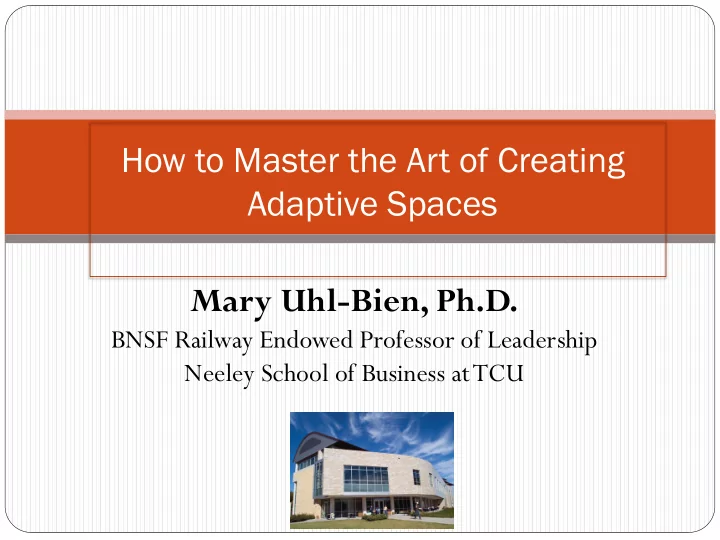

How to Master the Art of Creating Adaptive Spaces Mary Uhl-Bien, Ph.D. BNSF Railway Endowed Professor of Leadership Neeley School of Business at TCU
Key Questions What is adaptive space? How do we enable adaptive space (complexity leadership) in unfavorable environments? How do we measure and demonstrate outcomes? What skills and roles are required to create and sustain adaptive space?
What is Adaptive Space? Adaptive space is the conditions that enable the adaptive process to occur ADAPTABILITY THE NEED THE NEED TO TO INNOVATE PRODUCE
The Adaptive Process THE NEED THE NEED TO TO INNOVATE PRODUCE
The Adaptive Process Future Viability ADAPTABILITY Current Results THE NEED THE NEED TO TO INNOVATE PRODUCE ADAPTIVE SPACE
Conflicting and Connecting:
Connecting: Linking Up
Conflicting Recognize and engage adaptive tension Play in the pressures Expect conflicting and work to avoid “the brick wall” Cook the conflict Create “adaptive space” for conflicting to occur
Connecting In n the cont ntext xt of conf nflicting: icting: In n the form of link nking ing up up: Capturing ideas that spark Bringing “agents” together out of conflicting that could generate novelty “Both - and” thinking Foster network connections Finding ways to connect across differences — Enable or activate negotiation information flows Superordinate identity
What does adaptive space look like in our heads? Space to think, ideate, problem solve, create How can I…? How might I…? How do I overcome obstacles? How can I think in terms of “both - and?” Plan, strategize…
What does adaptive space look like in organizations? ENTREPRENEURIAL
What does adaptive space look like in organizations? ENTREPRENEURIAL ENABLING
What does adaptive space look like in organizations? OPERATIONAL ENTREPRENEURIAL ENABLING
Adaptive Space in Organizations Identify entrepreneurial leaders: 1. People with ideas Questioning status quo Advancing new ways of thinking Pushing for novelty Learning orientation Enable them to generate emergence 2. Have a supportive operational system 3.
Enable Emergence: Adaptive Space Individually (or small group): Give time to ideate, think, explore, create, innovate Provide resources Link up with others with ideas/information Support efforts to information gather across boundaries Seed money or access to equipment, technology, etc.
Enable Emergence: Adaptive Space Collectively: Foster network connections Link up with people in operational system Tie to strategic goals Navigate politics Examples: Advancing Healthcare Leadership programs Cook Children’s Innovation Department
Supportive Operational System Operational leaders who are motivated, incented and equipped to accommodate change into the operational system to foster adaptability Act as sponsors New Supportive IT Operational Order Leadership: Enabling Executing Aligning Leadership: Entrepreneurial Leadership:
What To Do in Unsupportive Management System Fly under the radar: Be discreet Scale through small changes Navigate power and politics carefully Tie to strategy and managerial goals Use informal system Take breathers to manage your own burnout Don’t be a threat
Demonstrate Outcomes Frame all activities and outcomes in context of strategic goals Put a business case around it Understand the financials and have financial people help you frame benefits If it is a learning outcome tie it to how it will lead to future results or enhanced viability Make friends with IT
Conclusion How you enable adaptive space depends on where you are in the organization Healthcare systems that are not set up for adaptability are contributing to the burnout problem Innovation spread in the context of CLT is not spreading one innovation but instead enabling more adaptability This often occurs on a local level It isn’t a one size fits all
Recommend
More recommend